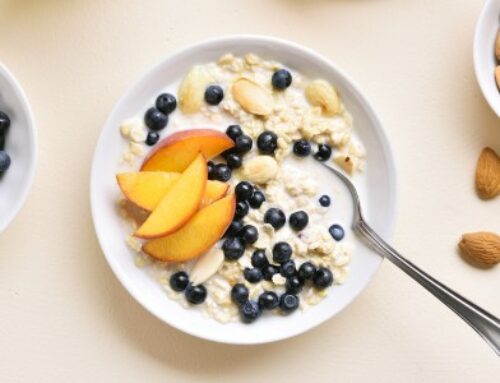
As we all know, sugary, ultra-processed foods can be very hard to resist. So what can you do to manage your food cravings and maintain your healthy habits? Here are 10 ideas to try, which may help you regain command and make mindful choices that you’re happy with.
1. Stay hydrated
Drinking an adequate amount of water is not only refreshing, but it can also help satisfy your thirst and potentially reduce your desire for additional snacks. When you feel the urge to reach for a sugary treat, try drinking a glass of water first. Afterward, give yourself 15 minutes to assess if the craving has passed. If plain water doesn’t appeal to you, you can try alternatives like green tea or herbal tea. Additionally, you may explore flavoured water recipes to add variety.
2. Maintain regular meals
Sometimes our perceived cravings for sweetness are actually a result of hunger. Providing your body with nourishing meals throughout the day can help stabilize your blood sugar levels and prevent impulsive food choices. Skipping meals can make it more challenging to stay consistent with your food choices. Aim to have a balanced breakfast, lunch, and dinner, ensuring each meal includes a good source of protein (such as meat, eggs, milk, yogurt, or tofu) and fiber (like whole grains, legumes, and vegetables) to promote satiety.
3. Moderate your access to sugary foods
Changing habits around sugar cravings often involves making it more difficult to indulge in sweet foods while making healthy options more accessible. Identify the times of day when your cravings are particularly strong and take steps to remove temptations during those times. For example, if you tend to crave sugary treats in the morning, try to avoid routes that pass by local shops or vending machines. If watching TV triggers your sweet tooth, clear your cupboards of tempting snacks and stock up on pre-cut veggies and dip as a healthier alternative. Involving your friends and family in your efforts can also be beneficial. For instance, suggest replacing an afternoon coffee and cake with a walk and ask your loved ones not to bring sweets as gifts.
4. Shop mindfully
It’s not uncommon to come home with sugary foods you hadn’t planned on buying due to the influence of advertising or impulse shopping. To regain command over your choices, consider the following steps:
- Create a shopping list and stick to it.
- Avoid shopping when hungry or stressed.
- Don’t bring hungry kids along while shopping.
- Have a healthy snack before heading to the shops.
- Steer clear of the confectionery aisle and explore snack options in the fresh produce, dried fruit and nuts, and dairy sections instead.
- Think twice before purchasing discounted sweets; consider the long-term costs.
- Be a snob and only buy the best quality, most favourite sweet options for you to eat when you choose to!
5. Keep healthy snacks on hand
Clearing your environment of sugary foods is more effective when you have tasty, healthy, and convenient alternatives to replace them. This way, you’re less likely to search for a sugar fix. Opt for snacks that provide a good source of protein, as they tend to provide better satiety compared to sugary options. Here are some examples (full recipes in our mobile app):
- Ricotta Whip Bruschetta
- Trail Mix
- Herby Yogurt Dip
- Fruit and Vegetable Tasting Plate
When you experience an afternoon energy slump, a handful of trail mix with nuts, seeds, and dried fruit can be a satisfying alternative to sweets. Fresh fruits are also a great choice when craving something sweet, as they are low in fat, rich in nutrients, and contain dietary fiber that promotes satiety. In the summer, take advantage of delicious seasonal fruits such as blueberries, cherries, mangoes, watermelon, passionfruit, peaches, and apricots.
6. Engage with Hobbies
Distracting yourself with an engaging activity can divert your attention from cravings and keep you physically and mentally occupied. Choose an enjoyable activity to make it easier to stick with it. Consider the following options:
- Going for a walk
- Reading a magazine
- Doing puzzles
- Having a chat with a friend
- Playing games with kids
If you have an artistic inclination, keep craft supplies on hand to unleash your creativity. At work, invite a colleague for a walk around the block. If you tend to give in to sugar cravings in the evenings, consider signing up for evening classes that provide fun and social engagement, such as pottery, woodworking, sewing, painting, dancing, yoga, tai chi, or learning a new language.
7. Reward yourself with non-food treats
Sweet foods are often associated with rewards for accomplishments or as a way to celebrate. However, daily consumption of such rewards can lead to increased sugar intake. When you feel deserving of a treat, explore non-food options that bring immediate joy and leave no regrets afterward. Take a relaxing bath, watch an episode of your favourite TV show, or share your success with a supportive friend. If you truly crave a delicious treat, consider enhancing a nutritious food with a small amount of something sweet. For example, you can sprinkle flaked almonds and crushed amaretto biscuits over a small bowl of natural yogurt with berries. Other ideas include a tropical fruit salad or raisin toast with ricotta and honey.
8. Manage stress and mood
Stress and negative emotions can intensify sugar cravings, creating a cycle of emotional eating that can be difficult to break. Taking steps to manage stress levels and improve mood can contribute to controlling sugar cravings. Prioritise a good night’s sleep and incorporate exercise into your routine, as these can help reduce stress. It can also be beneficial to talk to someone you trust and spend time with supportive individuals. Our habit building module: Emotional Aspects of Eating, is a great place to start! You can find it in our mobile app.
9. Enjoy Physical Activity
Engaging in physical activity can lead to a preference for healthier foods. If you find that a sedentary day increases your sugar cravings, try going for a short walk or engaging in light exercise to combat the craving. Regular physical activity is essential for maintaining a healthy body. However, be mindful not to reward yourself with sugary foods after exercise. Research has shown that when people find physical activity enjoyable, they are less likely to indulge in unhealthy snacks afterward. Choose an exercise routine that you find enjoyable and fun, such as running while listening to your favourite podcast or inviting a friend for a scenic bike ride.
10. Choose quality over quantity
Managing sugar cravings doesn’t mean completely eliminating sugary foods from your diet. It’s important to strike a balance and make choices that align with your overall well-being. When you decide to indulge in something sweet, make it a deliberate choice and savour the experience. Avoid mindlessly consuming any sweet food that is readily available. Instead, choose a portion of something special and truly enjoyable. This way, you can appreciate the treat without feeling the need for excess.
If you’d like further help with your nutrition please click below:
This article was originally written by Julia Christenson, intern from the University of Canberra.
References
Duyff, R.L., Birch, L.L., Byrd-Bredbenner, C., Johnson, S.L., Mattes, R.D., Murphy, M.M., Nicklas, T.A., Rollins, B.Y. & Wansink, B. 2015, “Candy consumption patterns, effects on health, and behavioral strategies to promote moderation: Summary report of a roundtable discussion”, Advances in Nutrition, vol. 6, no. 1, pp. 139S-146S.
Elder, S.J. & Roberts, S.B. 2007, “The effects of exercise on food intake and body fatness: A summary of published studies”, Nutrition reviews, vol. 65, no. 1, pp. 1-19.
Laska, M.N., Hearst, M.O., Lust, K., Lytle, L.A. & Story, M. 2014, “How we eat what we eat: Identifying meal routines and practices most strongly associated with healthy and unhealthy dietary factors among young adults”, Public health nutrition, vol. 18, no. 12, pp. 2135-2145.
Morris, M.J., Beilharz, J.E., Maniam, J., Reichelt, A.C. & Westbrook, R.F. 2015, “Why is obesity such a problem in the 21st century? The intersection of palatable food, cues and reward pathways, stress, and cognition”, Neuroscience & Biobehavioral Reviews, vol. 58, pp. 36-45.
Rampersaud, G.C. 2009, “Benefits of Breakfast for Children and Adolescents: Update and Recommendations for Practitioners”, American Journal of Lifestyle Medicine, vol. 3, no. 2, pp. 86-103.
Tal, A. & Wansink, B. 2013, “Fattening fasting: Hungry grocery shoppers buy more calories, not more food”, JAMA Internal Medicine, vol. 173, no. 12, pp. 1146-1148.
Werle, C.O.C., Wansink, B. & Payne, C.R. 2015, “Is it fun or exercise? The framing of physical activity biases subsequent snacking”, Marketing Letters, vol. 26, no. 4, pp. 691-702.







